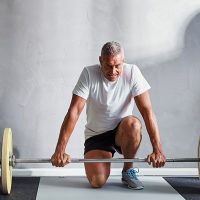Our muscle plays a critical role in healthy aging and Master’s Powerlifter Brad Gillingham is here to share some ways to combat age-related muscle and strength loss.
Staying Strong for Life
It is no secret that as we age, we lose muscle and strength. It takes longer to recover between workouts, and everything seems to hurt a little more. Age-related loss in strength and muscle mass is called sarcopenia. Muscle loss, typically begins around age 40 and accelerates as we get older.1 Similar to osteoarthritis, setting into worn and damaged joints, muscle loss eventually steals from our strength, and our ability to train as hard as we did in our youth. I was fortunate to have minimal decline in strength in my 40’s, but then along came 50!
A listing of USA Powerlifting American Record Deadlifts in the Super Heavyweight Class provides a good example of how age-related strength declines. 2
- Open – 903 lbs.
- Master I (40-49) – 881 lbs.
- Master II (50-59) – 766 lbs.
- Master 3 (60-69)- 639 lbs.
Age-related decline in performance is the reason why age-based competitions are common in most sports. In USA Powerlifting the Master’s Class starts at age 40, and different competition classifications are designated every 10 years (Masters I-II-III-IV…).
Does loss of strength and the ability to train as hard as we used to mean that we should give up on training heavy as we get older? Absolutely not! As we age the greatest thing we can do to maintain or increase strength and muscle mass is to continue to lift and stay active. In fact, often times you hear that older adults should not lift heavy weights to avoid injury. Research indicates that this is not true even for adults over 65. A meta-analysis of 29 studies involving adults over 65 indicated the importance of training with high intensity strength training >75% 1RM to maintain or increase strength.3 Another study completed in Germany suggested adults >60 should be training >85% 1RM to maximize strength.4 Age is no excuse to give up heavy strength training.
Adjusting your Training as You Age
There has been a considerable amount of research involving athletes and the aging process. A 2010 study published in the European Journal of Applied Physiology indicated that Masters athletes experience similar fatigue and muscle damage as younger athletes, but the recuperation and recovery time is slower.5 I have definitely had to make adjustments to my training. Throughout my 20’s and 30’s I trained with a high volume of repetitions, sets, and frequency. For example,5×5 squatting was the staple of my training cycles. My typical cycle involved squatting 5×5 with increased intensities week after week. I would only occasionally work in an active recovery (8x2x60% 1RM) session. In my 40’s it became more difficult to repeat 5×5 squatting week after week. At this point, I built in more of the active recovery (8x2x60% 1RM) sessions into the cycle. In my 50’s, 5×5 squatting became increasingly difficult, both from a recovery standpoint, and due to deteriorated knees. I have reduced my heavy training down to 3 sets of 5, and I now include more partial range of motion movements like rack squats in order to train heavy, but give my knees a much needed break from squatting below parallel.
Generally, I have incorporated less volume with all three lifts (squat, bench, deadlift) and I incorporate more heavy power rack partials to reduce the strain on my aging joints. I take more time off between heavy training sessions and I implement more active recovery/mobility workouts. I also incorporate more functional strength/strongman exercises like sandbag carries, farmers walks and sled push/pull to work on strength endurance /conditioning. Diet, rest and supplementation have become more and more critical. I pay more attention to what I eat and and I keep on a consistent supplementation plan that includes myHMB, PEAK ATP, creatine, protein, amino acids, vitamins, and joint support.
Keep up the Good Fight
For me, resistance training and exercise are the fountain of youth for both physical and mental health. I have to admit I still like to battle with the younger athletes, but I have found Masters competition to be very enjoyable. My suggestion is to adjust your goals as you age, find something to train for and compete for life. If you are not a competitive athlete, compete against yourself. If lifting isn’t your thing maybe its running, swimming, CrossFit, or bicycling. Make sure to incorporate some resistance training into your workouts to maintain muscle mass and strength. Remember, every day isa good day to set your personal best.
References:
- Columbia University Medical Center. Study explains why muscles weaken with age and points to possible therapy. ScienceDaily. Published August 3, 2011.
- USA Powerlifting American Records. (August 5, 2020). http://usapl.liftingdatabase.com/records
- Steib S, Schoene D, Pfeifer K. Dose-Response Relationship of Resistance Training in Older Adults. Medicine & Science in Sports & Exercise. 2010;42(5):902-914. doi:10.1249/mss.0b013e3181c34465
- Mayer F, Scharhag-Rosenberger F, Carlsohn A, Cassel M, Müller S, Scharhag J. The Intensity and Effects of Strength Training in the Elderly. Deutsches Aerzteblatt Online. 2011. doi:10.3238/arztebl.2011.0359
- Easthope CS, Hausswirth C, Louis J, Lepers R, Vercruyssen F, Brisswalter J. Effects of a trail running competition on muscular performance and efficiency in well-trained young and master athletes. European Journal of Applied Physiology. 2010;110(6):1107-1116. doi:10.1007/s00421-010-1597-1





